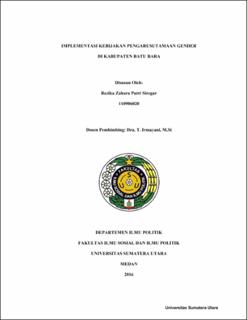| dc.description.abstract | This study aims to determine how the implementation of gender
mainstreaming in the district of Batu Bara and to know the results of the
implementation of gender mainstreaming for women in the district of Coal.
Implementation of gender mainstreaming aims for the integration of the interests,
aspirations and conditions of men and women who can be met among others with
the involvement of men and women in the development process, especially as
decision makers, as well as the realization of gender equality means that men and
women can equally enjoy the fruits of development. In this study is devoted to the
execution or implementation of gender mainstreaming policies on women in the
areas of labor, education and health.
The theory used in this research is the theory of Public Policy by James
Anderson who explained the implications of public policy, where such measures
are goal-oriented, the act constitutes a pattern of government action or officials, is
what the government could mean or do anything, be positive, which means is
some form of government action on specific issues, and negative as the
government's decision not to do something. Also used the theory of Public Policy
Implementation by George C. Edwards, where he stated the policy
implementation is one of the stages of public policy, between policy formation
and policy consequences for the people they affect. In reviewing policy
implementation, there are four factors or variables crucial in the implementation
of public policy, including communication, resources, disposition and
bureaucratic structure. In addition it also used the Gender Theory, according to
Women's Studies Encyclopedia gender is a cultural concept that seeks to make a
distinction in terms of roles, behavior, mentality, and emotional characteristics
between men and women who thrive in the community. In the discussion on
gender, including gender equality and justice, known as the second stream is the
theory or theories of nurture and nature theory and the theory of equilibrium, but
this study specializing in the nurture theory.
This research is descriptive research with qualitative analysis method. In
this study the authors used data collection techniques by collecting primary data
and secondary data. Primary data were collected through interviews (interview),
addressed to the Head of the Department of Labor, Dept. of Education, Head of
Department of Health and Head of Women Empowerment, DPRD Commission C,
along with the Regional Development Planning Agency.. While secondary data
collection done by collecting data and information through books, the Internet,
and journals related to the research problem. Based on the analysis of the results
of this study, the authors concluded that the implementation of gender
mainstreaming policies in Batu Bara was not fully achieved, especially the
implementation of gender mainstreaming policy is only implicit in the fields of
employment, education and health. But that does not mean that gender
mainstreaming policies that are not appropriate to reduce gender issues in the
district of Batu Bara. Failure is not about the public policy (gender
mainstreaming), but the implementation that is not good by the rest of the
bureaucracy or implementing the policy. | en_US |

